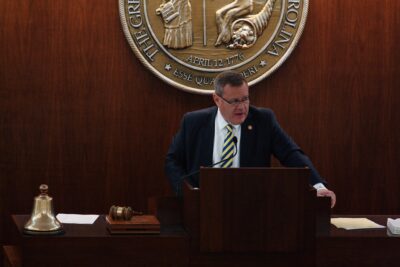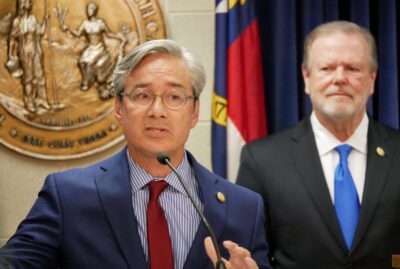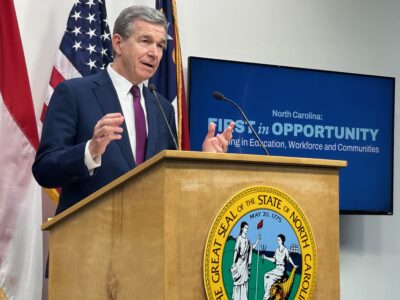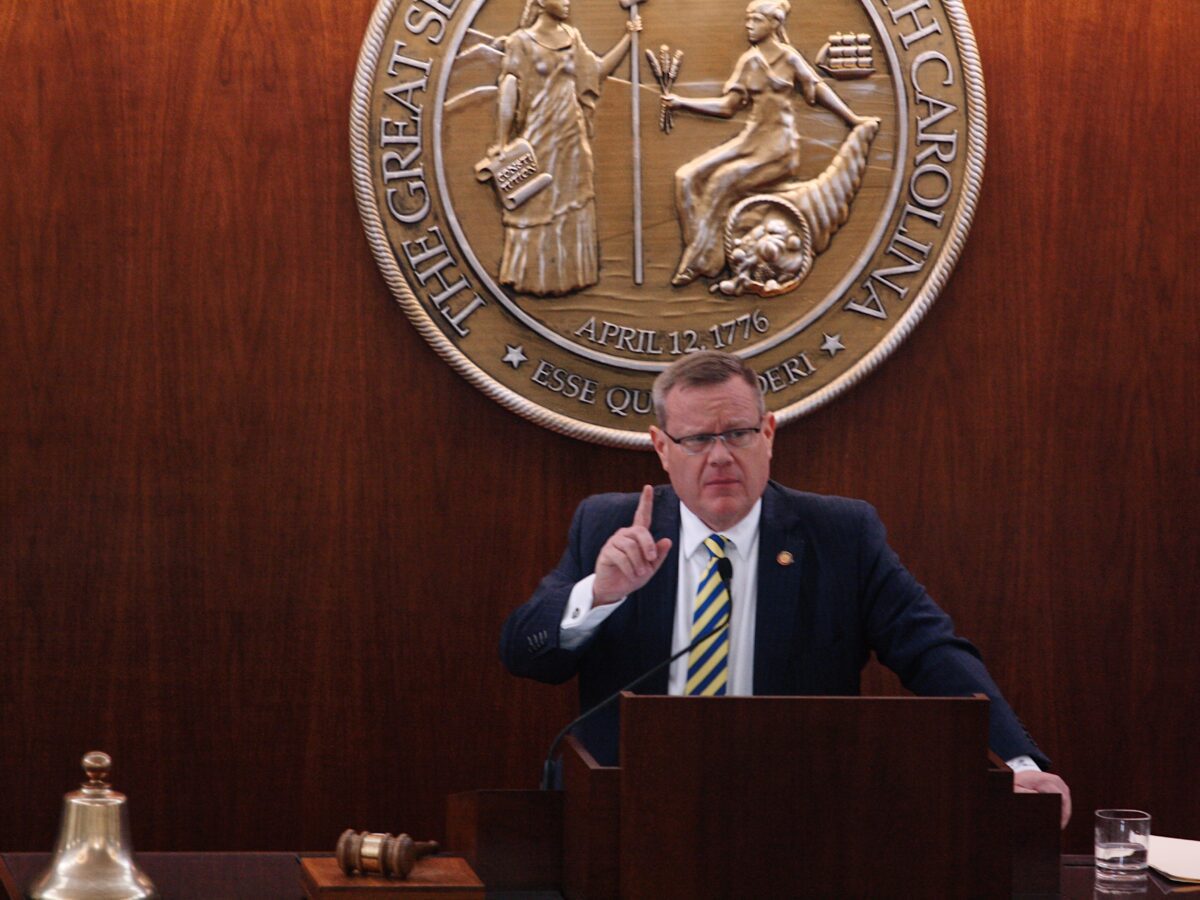

|
|
Historically, education is the largest area of the state budget — and that is true again in this year’s new state budget, passed on Sept. 22 by the Republican-led General Assembly.
The new state budget’s net appropriation for education is $17.3 billion in 2023-34 and $17.9 billion in 2024-25 – making up 58% of each spending plan.
The budget’s net appropriation for K-12 education items is $11.6 billion in the first year and $12 billion in the second. For context, the budgeted net appropriation for K-12 education in 2015 was $8.5 billion. This year’s budget also includes approximately $4.4 billion to the UNC System and $1.5 billion to the N.C. Community College System (NCCCS) for both years of the biennium.
While education is the largest portion of the budget, there is disagreement among Republicans and Democrats — along with education stakeholders — about which education issues a budget should prioritize.
Take for instance, the vast expansion of school choice included in this year’s budget. The budget provides for universal private school vouchers through the Opportunity Scholarship Program by removing all income eligibility requirements for recipients starting with the 2024-25 school year. The budget adds $250 million to the Opportunity Scholarship Grant Reserve over the biennium, putting the revised appropriation for the reserve at $618 million over the next two years.
President Pro Tem Sen. Phil Berger, R-Rockingham, who previously called the proposal the “largest expansion of school choice” since the state started the Opportunity Scholarship program 10 years ago, said the new budget “puts student outcomes and parental choice ahead of bureaucracy.”
On the other hand, Democratic Gov. Roy Cooper said the budget “seriously shortchanges our schools.” House Minority Leader Rep. Robert Reives II, D-Chatham said the budget “siphons money from public schools, (and) provides raises to state employees and educators less than inflation.”
During last week’s voting sessions, many Democrats harshly criticized the budget, specifically naming the large investment in private schools through vouchers, rather than investment in public schools and public school employees.
What do you think? Below, you can find an analysis of the education items in the new budget, including private school vouchers, teacher pay, school funding, nutrition, curriculum, and more. Take a look and let me know what you think.
You can also check out the 625-page bill text for the compromise budget, and the money report for the budget.
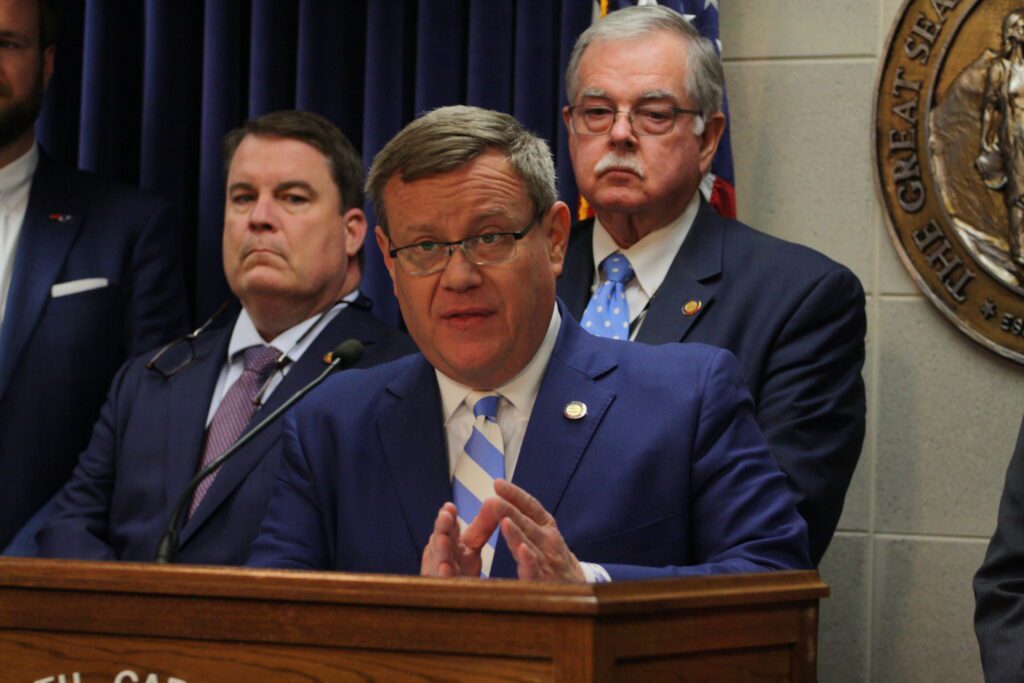

The budget process
The General Assembly meets for its regular, “long” session beginning in January of each odd-numbered year. On even-numbered years, lawmakers reconvene for the “short session,” which typically begins in May.
Ideally, each long session wraps up by July 1, so the state can have an updated budget for the new fiscal year.
North Carolina operates on a biennium budget, meaning that each budget covers two fiscal years. Accordingly, the budget passed last week provides state funds for 2023-24 and 2024-25.
The compromise budget document was finally made public last Wednesday afternoon, nearly three months after the new fiscal year started. The first round of voting on the budget started less than 24 hours later on Thursday morning.
Back in January, lawmakers were optimistic they would finish the budget well ahead of the fiscal year.
Democratic Gov. Roy Cooper released his two-year spending plan in March, proposing a 16% pay increase for teachers over two years and full funding for the Leandro comprehensive plan. The new state budget does not explicitly mention funding Leandro. The General Assembly’s current shortfall for Years 2 and 3 of the Leandro Plan, administered through the Department of Public Instruction (DPI), is nearly $510 million, per an April court order. (On May 5, Berger and Moore filed an appeal to that order.)
The Republican-led House passed its budget in April, proposing a 7.50% across-the-board pay raises for teachers over the biennium, with an average pay raise of 10.2% for teachers slated to get step increases. The Republican-led Senate passed its budget in May, proposing much smaller pay raises for teachers along with an even more significant expansion of private school vouchers.
In June, Republicans released a list of the lawmakers working on a compromise budget. The 2023 budget conferees included six Democrats. Four of those members – Reps. Shelly Willingham, Cecil Brockham, Michael Wray, and Garland Pierce – were swing votes this legislative session.
Despite the Republicans having a supermajority in the state legislature, it took them five months to develop and pass a compromise budget.
Last Friday morning, Cooper said he was “directing our Department of Health and Human Services to begin today the process for expanding Medicaid while allowing this budget to become law without my signature.” The budget is expected to expand Medicaid to more than 600,000 North Carolinians, starting Dec. 1.
It’s important to remember that the state started the budget process anticipating a $3.25 billion surplus. In May, the Office of State Budget and Management (OSBM) and the General Assembly’s Fiscal Research Division issued a revised consensus revenue forecast predicting a slightly smaller surplus, down by $135.8 million, or a decrease of 0.4%.
While many Democrats advocated using the surplus for things like teacher pay and Leandro, Republicans opted for a more reserved approach. The new budget grows the state’s “rainy day fund” balance by $125 million to just under $5 billion.
The budget also decreases income tax rates, which Republican leaders say will “return $1.2 billion to North Carolina families and businesses.” The Office of the Governor previously said the cuts could “severely limit the state’s ability to fund public education moving into the future.”
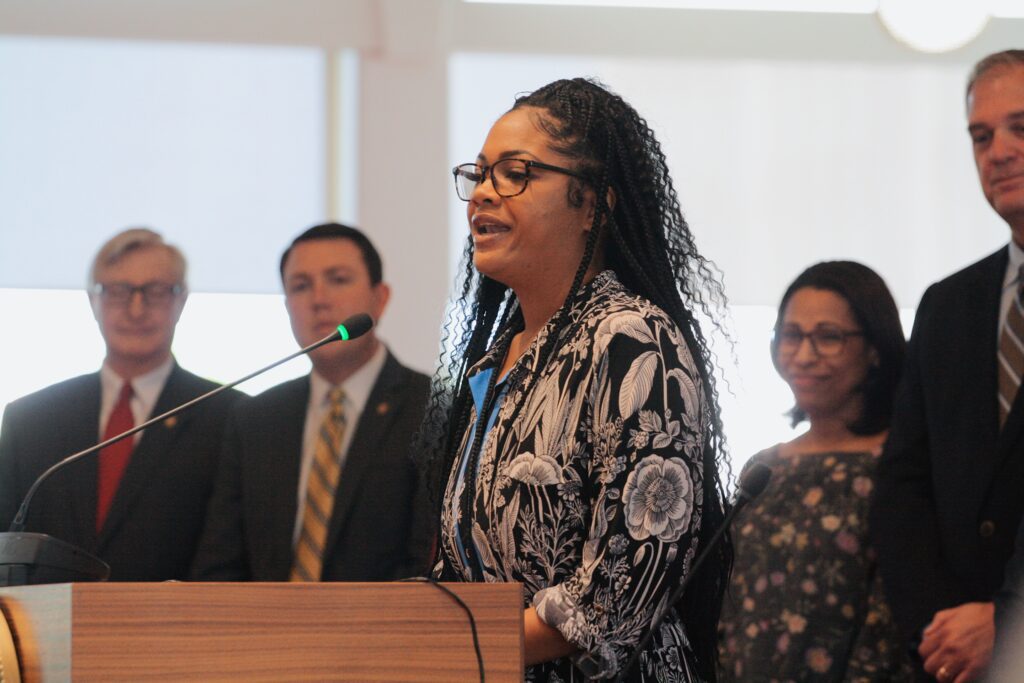

Private school vouchers
The state’s private school voucher program currently targets low-income students. While awards will still be prioritized for low-income students in the new budget, there will be no income eligibility requirements starting in the 2024-25 school year. The budget also eliminates the requirement that a student needs to have previously attended a public school.
As mentioned above, the budget adds $250 million to the Opportunity Scholarship Grant Reserve over the biennium, putting the revised appropriation for the reserve at $618 million over the next two years. While the money report includes this change, the bill text does not.
The bill text provides the base budget set for the biennium, while any changes to that base amount are included in the money report.
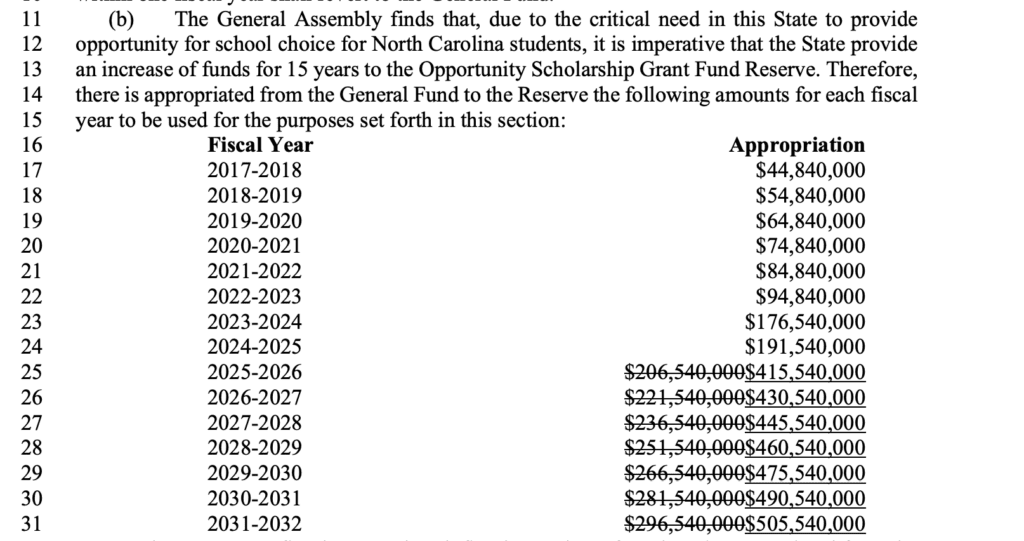



Including the additional funds over the biennium included in the money report, the new budget allocates a total of $4.4 billion to the Opportunity Scholarship Grant Fund Reserve over the next decade. The budget increases the allocations to the reserve over the next 10 years by more than $1.9 billion.
The money report says that the increase in funds over the biennium is “intended to help prevent a waitlist for the program.”
EdNC could not confirm how many people are on the waitlist before publication, or if such a waitlist exists. Historically, there have been unspent funds of those allocated for Opportunity Scholarships.
According to the budget bill, “these funds shall be used to award scholarship grants to eligible students for the school year that begins in the fiscal year following the fiscal year in which the appropriation is made to the Reserve.”
EdNC will continue to report on how the voucher expansion could impact public schools, who rely on a measure of enrollment for their funding.
Following the Senate’s prioritization of school choice expansion in its May budget, Cooper declared a state of emergency for public education in North Carolina.
“… It’s clear that the Republican legislature is aiming to choke the life out of public education,” Cooper said at the time.
As EdNC previously reported, in other states where significant policy changes are implemented that could impact average daily membership (ADM), stabilization funds have been proposed for districts.
Neither the Senate budget nor the compromise budget includes such stabilization funds. However, starting in the 2025-26 school year, the budget says “it is the intent of the General Assembly to reinvest in the public schools any savings realized by the State each year” when a student accepts a scholarship “that is less than 100% of the average State per pupil allocation for average daily membership for a student in a public school unit.”
Students who qualify for reduced-price lunch can receive a scholarship of up to about $7,500 annually. Wealthier students will receive smaller vouchers, up to 45% of what the state pays on average for a public school student. These are the state “savings” that could get returned to public schools, for students who apply for and receive a voucher starting in fall 2025.
By 2031-32, the new budget allocates more than $505 million to the Opportunity Scholarship reserve. From 2032-33 on, the budget allocates more than $520 million to that fund.
In the months following the proposal, a bipartisan group of education stakeholders have raised concerns over the proposed voucher expansion. Primary concerns include the lack of testing accountability at private schools, the impact of the expansion on funding and enrollment at public schools, and that private schools don’t have to serve students with disabilities.
At last Thursday’s House session, Rep. Ashton Wheeler Clemmons, D-Guilford, spoke about meeting a mom who tried to use the Opportunity Scholarship program for her son, David, who is autistic. None of the three private schools they visited would admit him, Clemmons said.
“This budget abandons the commitment to public schools, who serve each and every child as fundamental to who we are in our state, to use billions of taxpayer dollars to private schools who are allowed to discriminate against the very children most depending on us, like David,” Clemmons said.
Historically, most vouchers also go to religious schools, WRAL reported, with eight of the 10 top recipients of Opportunity Scholarships being Christian-affiliated schools. Critics say some religious schools reject certain students, such as LGBTQ+ students and students with a different religious background.
The compromise budget does add slightly more accountability to the program, requiring that nonpublic schools that accept students who receive Opportunity Scholarships to administer standardized tests. Schools with at least 25 voucher recipients in each grade must share results with the state – but those results are exempt from public records.
A bill was introduced earlier this session to allow homeschool students to be eligible for Opportunity Scholarships, but that provision didn’t make it into the budget.
Last week, several Democrats highlighted the large investment in private school vouchers – and the lack of fulfillment of the Leandro plan. Several also mentioned that most students in rural counties — many of which do not have private schools — will be unable to take advantage of the expanded vouchers.
“We’re already underfunding public education to the point that courts have repeatedly said we are violating our constitutional duty and not providing a sound basic education through fiscal neglect, and this predominantly affects kids growing up in the poorer parts of our state,” said Sen. Lisa Grafstein, D-Wake. “This budget not only fails to provide for the remedy, called for in Leandro, but will undercut future efforts to meet the educational needs of students throughout the state. It shifts the cost to counties that can least afford to make up the deficit.”
The budget also requires the State Board of Education to create a three-year graduation track for high school students by Nov. 1.
Students who opt for that track — and who also seek a degree, diploma, or certificate at an eligible postsecondary institution — will be eligible for “early graduate scholarships” based on financial need. Read more starting on page 194 of the budget.


Pay raises
The budget gives larger raises to beginning teachers, with raises decreasing with years of experience. Those base salary raises range from 3.6 to 10.8% over the biennium.
Beginning teacher pay is set to increase from $37,000 to $41,000 over the next two years, according to the budget – an increase of 10.8%.
When you compare the proposed salary schedule for 2023-24 to last session’s teacher salary schedule, which is the one currently in place, the increase for teachers with 15 years or more of experience is a 3.6% raise over the biennium, or about $188 per month, before taxes.
The budget says teachers will also get step increases and could qualify for advanced teaching roles and supplements. Importantly, teacher supplements vary widely by district.
Most other school employees will receive a 7% raise over the next two years. There is also $4.8 million recurring each year of the biennium to implement additional 2% salary increases on top of the 7% for bus drivers in 2023-24.
Lawmakers previously said that pay raises would be retroactive to July 1. With the budget expected to pass without the governor’s signature on Oct. 3, it is likely employees will start seeing the raise in their paychecks at the end of October.
The budget also provides a one-time cost-of-living supplement to retirees of 4% in 2023-34 — to be paid “on or before Nov. 30.”
Notably, the budget does not include anything regarding the State Board of Education’s March request to run a six-year pilot of its plan to reform licensure and teacher pay in North Carolina.
You can read more about the specific pay schedules and supplements outlined for teachers, including local supplements and supplements for advanced teacher roles, in the article below.
Charter schools
In addition to expanding school choice through private schools, the budget also expands choice through charters, which are public schools with more flexibility. While charter schools demonstrate the choice already available in the public school system, traditional public schools remain the top choice for most of the state’s students.
The General Assembly established charter schools in North Carolina in 1996. Last academic year, there were 206 charter schools in the state.
State law previously gave the State Board of Education sole authority of charter school oversight in the state, including the approval and renewal of charters. The Charter Schools Advisory Board assisted the Board by providing recommendations. That advisory board was assisted by the Office of Charter Schools.
The State Board of Education approved 26.26% of charter school applications on average between 1997 to 2022.
Given a law enacted in August, the former Charter School Advisory Board no longer exists. Instead, a newly established Charter School Review Board has authority to approve charter applications, renewals, and material changes. Under the law, the Board can only appeal the review board’s decisions.
“This action will make the application process more efficient, more cost-effective, and much more streamlined for all stakeholders involved,” said Rep. Tricia Cotham, R-Mecklenburg, a primary sponsor of the bill.
In September, the Board voted to enact a policy that would allow it to exercise its constitutional responsibility of financial accountability over charter schools. The policy would require the review board to present approvals to the board before any state or federal funds are to be disbursed.
“We take our funding responsibilities seriously,” Chair Eric Davis said. “We aim to work in a collaborative way with the Charter Review Board.”
The new budget limits that discretion. Per the budget, the Board can only withhold funds to charter schools in three specific circumstances, listed below.
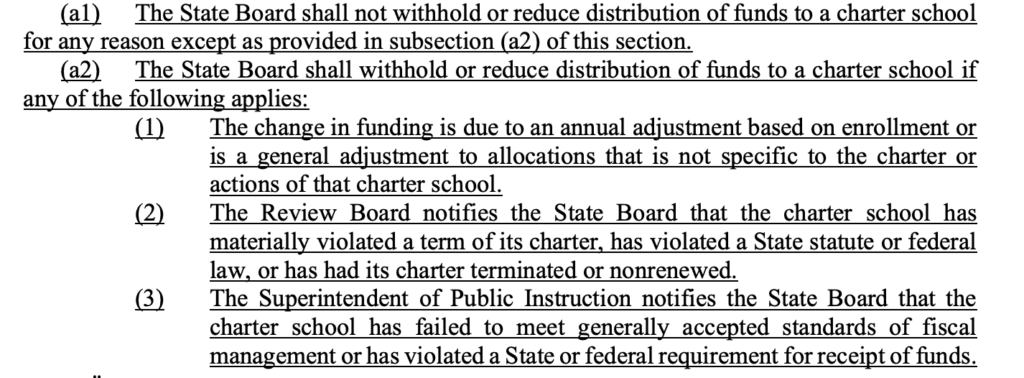

The budget includes a few other items regarding charter schools.
- There are recurring funds for a new assistant director position in the DPI Office of Charter Schools, including operating costs — $101,938 in the first year, $130,382 in the second.
- The budget also requires DPI to reclassify one position “to be a Read to Achieve Charter School Coordinator.”
- There is also additional funding for the Charter School Transportation Grant Program, now $2.5 million each year.
- Finally, the budget lays out guidelines for remote charter academies and enrollment starting on page 94 of the bill text.
School funding
The budget allocates a little more than $20 million in each year of the biennium “for an allotted ADM of 1,549,792 students in FY 2023-24.”
There is a provision in the budget instructing DPI to develop a funding in arrears model, which means public school funding would be based on the actual average daily membership (ADM) from the prior school year, instead of projections for the upcoming school year.
Under the proposal, DPI would have to distribute funding in arrears starting with the 2024-25 school year.
“The Department shall provide funds from the ADM Contingency Reserve to fund public school units whose actual ADM for the current school year is higher than the actual ADM from the prior school year,” the budget says.
In March, Senate Republicans filed Senate Bill 670, which would abolish “all funds, grants, allotments, and other sources of funding that expend their funds from the State Public School Fund,” to enact a weighted student funding model.
That proposal is not included in the new budget. However, the bill text of the budget does direct DPI to study and create a weighted model for Exceptional Children (EC) students. The model should fund children “on the basis of the reported cost of services provided.” DPI must report back to lawmakers by Jan. 15, 2024 with such a model, along with a comparison to funds under the existing model.
There is also $8 million over the biennium for DPI “to allot additional flexible funds to schools with a student population made up of more than 80% economically disadvantaged students that exceed growth on school-wide Education Value-Added Assessment System (EVAAS) measures.”
The budget also provides additional funding for the Transportation Reserve Fund for Homeless and Foster Children. The revised appropriation is $3 million each year.
Finally, as noted above, the budget does not explicitly fund Leandro.
School curriculum
The budget extends the implementation of new legislation, commonly known as the Parents’ Bill of Rights, to Jan. 1, 2024.
The budget exempts the Youth Risk Behavior Survey from the law’s protected information survey provision, now allowing parents to opt out of the survey rather than requiring them to opt in.
The budget also clarifies that parents will not need to be notified or provide consent when school personnel act in a medical emergency.
The legislature also recently passed a law requiring the State Board of Education to include instruction in computer science in the standard course of study for middle and high school students. Those requirements would start during the 2024-25 school year.
The budget does not include funding for implementation of those newly required courses. It does allocate $500,000 in nonrecurring funds in 2024-25 “for K-12 teachers across the State to receive training in computer science.”
Literacy
The budget also includes a few items on literacy.
There is $1.7 million in the first year for DPI to contract with JFL Enterprises, Inc. “to provide a program for reading remediation for middle school students.” Additionally, DPI will use up to $300,000 in unspent federal relief funds in 2023-24.
There is also $750,000 of additional funding each year for the Early Learning Specialist positions created in 2022. These additional funds will be used to assist DPI in filling positions vacant as of July 1, 2023. The revised net appropriation for this purpose is $14.8 million in each year of the biennium.
Finally, the budget prohibits “three-cueing,” which is a method of teaching students to read based on meaning, structure and syntax, and visual cues. You can read more about how the state is changing how it teaches reading here.
Career development
There are several provisions in the budget concerning career development for middle and high school students.
The budget directs the State Board of Education to develop standards for a new career pathways course in middle school. That course will help meet another new requirement, which requires seventh graders to develop career development plans in order to move to the next grade level. In 10th grade, students must revise that plan to move to the next grade.
The Board must pick at least 20 local school administrative units to pilot the career development plan requirements during the 2023-24 year. Then, the budget says, the state will implement the full plan in 2024-25.
Charter schools are not required, but encouraged to make such plans. You can read more about the required plans on page 87 of the bill text.
Here are other career development-related items in the budget:
- There is funding for a state CTE coordinator, $95,000 each year.
- $4 million over the biennium for a grant program to allow schools to purchase a digital CTE learning platform.
- $2 million over the biennium to DPI to create a competitive grant program for public school units to promote health careers to high school students and their families.
- $1 million in the first year to DPI to create a competitive grant program for public school units to engage in experiential science, technology, engineering, and math (STEM) programs.
- $2.5 million each year to DPI to contract with MyScholar, LLC to create a 12th-Grade Transition Pilot for all high school students.
- $3 million over the biennium for DPI to contract with Betabox, Inc. to provide public school units with curriculum, instructional coaching, hands-on experiences, and other resources in STEM subjects. These funds are in addition to $1.0 million provided in federal relief funds in 2023-24.
- $4.8 million over the biennium for for DPI to contract with Plasma Games, Inc., to make available to public school units STEM-focused educational software in STEM and CTE classes.
School safety and health
There is $35 million in recurring funds both years for school safety grants, which is similar to last year’s allocation. The budget also allocates $1.7 million over the biennium to the Center for Safer Schools’ anonymous tip line, which facilitates anonymous reporting of school safety threats.
There is also $900,000 in the first year for the Center for Safer Schools to conduct a school safety awareness campaign and continue contracts to conduct threat assessment team development.
N.C. Emergency Management will also get $4 million in recurring funds over the biennium to “help schools build emergency plans and make those plans available to first responders.”
The budget creates a new School Health Personnel Allotment. Under the proposal, this allotment will now include the previously named School Psychologist Allotment to cover all health categories.
There is also a recurring increase in funding to add about 120 nurses, counselors, social workers, and psychologists across the state – which adds just over one health personnel per school district. The revised total requirements for this allotment are $347.4 million in each year of the biennium.
The budget does not include any language from HB 382, which would allow registered nurses with at least two years of experience to work in schools. Under that bill, school nurses would no longer have to, within three years of being hired, earn a bachelor’s degree and a National Certification for School Nurses.
The budget also includes:
- $12 million over the biennium for classroom supplies.
- $250,000 each year to provide additional funds for feminine hygiene products for students. The revised appropriation is $500,000 each year.
- $500,000 each year for DPI to contract with the Children and Parent Resource Group, Inc. for the Life Changing Experiences Program, “a 3-dimensional and interactive multimedia education program that focuses on activities that negatively impact teenagers, including alcohol and drugs, dangerous driving, violence, and bullying.”
School nutrition
For two school years during the pandemic, all students, regardless of income, could eat school meals for free. Since the waivers providing free meals ended, meal debt across the country has grown.
Many education advocates called on lawmakers to provide for the continuation of free school lunches in the budget. That provision did not make it into the budget, but a few others did.
First, the budget includes funding to permanently eliminate the reduced-price lunch copay in North Carolina. In other words, students qualifying for reduced-price lunch will now receive those meals at no cost to their families. The reduced-price breakfast copay was eliminated in 2011.
The budget provisions, and especially the recurring funding to permanently eliminate the reduced-price lunch copay, are important incremental steps toward school meals for all in North Carolina. During the time the North Carolina General Assembly worked on the budget, schools in nine states started the school year offering school meals to all students at no cost to their families. These children, families, and communities, are reaping the many benefits of school meals for all: improved academic outcomes, better attendance, fewer disciplinary issues, reduced child hunger, and the elimination of meal debt and lunch shame and stigma.
The School Meals for All NC Leadership Team
The budget also eliminates penalties for unpaid student meal debt.
There is also $500,000 in the first year and $6.3 million in the second for DPI to create a Community Eligibility Provision (CEP) pilot. The pilot would support schools participating in CEP, which allows participating schools to provide school meals at no cost to families
The budget directs DPI to prioritize schools with an Identified Student Percentage above 55%.
Data and digital learning
There are several provisions to increase data capabilities at DPI in the budget.
There is an increase in funding for the Uniform Education Reporting System (UERS), which supports multiple software platforms provided to public school units, including a student information system. The revised net appropriation for UERS is $11.5 million in each year of the biennium.
The budget also includes $550,000 each year for DPI to contract with SAS to analyze recovery data, student projections to pre-pandemic expected performance, and reporting on year-over-year modeling in the third year of learning recovery.
There is an additional $465,000 each year for DPI to contract with SAS for work on analytics, including student group reporting and topics related to student growth and teacher effectiveness.
The budget also includes new funds to increase cybersecurity across the state. There is $5 million each year “to acquire prevention, detection, and remediation services for advanced malware threats most commonly delivered to employees and students via email.” The revised net appropriation for the School Connectivity Initiative is $42.3 million in each year of the biennium.
There is also $600,000 each year for additional cybersecurity awareness training for all public school unit staff and teachers.
There are several provisions to enhance digital learning programs across the state:
- $2.2 million each year of the biennium to increase funding for the digital learning plan — described in sec. 7.23K. The revised appropriation is $6.2 million in each year of the biennium.
- $100,000 in 2023-24 and $4.4 million in 2024-25 for DPI to contract with Gaggle.Net, Inc., and Liminex, Inc., d/b/a/ GoGuardian to provide technology and services to mitigate cyberbullying, monitor student internet activity, and assist with suicide prevention services. These funds are in addition to $4.3 million in federal relief funds for 2023-24.
- $975,000 each year for DPI to contract with Amplio Learning Technologies, Inc. to pilot a special education digital intervention software platform in Alamance, Catawba, and Nash county schools.
- $3 million each year to support the SparkNC Pilot Program, which is a partnership between SparkNC and public school units, to develop a pathway for students to complete modular learning experiences that provide a competency-based equivalency to a traditional elective course credit.
Other K-12 items
- Instead of granting calendar flexibility, the budget also creates a high school remote instruction flexibility pilot. The state superintendent will pick 10 high schools to participate in the pilot, for the 2023-2024 through 2027-2028 school years. The pilot will allow students to take first-semester exams before Dec. 31. The pilot would also allow the schools to use up to 30 hours of remote instruction to take the exams by that point.
- There is $2 million over the biennium to create a grant program for eligible teacher apprentices to receive funds to cover tuition for educator preparation programs and salary supplements if they become teachers.
- There is also $1 million in 2024-25 to cover fees for teachers pursing National Board for Professional Teaching Standards (NCPTS). These funds are in addition to $1.0 million existing in federal Elementary and Secondary Schools Emergency Relief Fund (ESSERF) receipts in FY 2023-24.
- The budget also expands the NC Teaching Fellows Program to include 10 institutions, instead of eight, along with K-6 teachers. The program previously included only STEM and special education teachers. The scholarship amount is also increased from $4,125 to $5,000 per semester.
- The budget includes $3 million in 2024-25 to NC Education Corps for the purpose of partnering with public school units to recruit, train, and deploy corps members to work as tutors and mentors with public school students.
- The budget also provides up to $4,600 per year, up to four academic years, to current teacher assistants as they pursue a college degree resulting in teacher licensure.
- There is $400,000 each year for N.C. Center for the Advancement of Teaching (NCCAT) to hire additional personnel and adjust current salaries to expand services. These additional funds are meant to help NCCAT to serve more teachers each year.
Early childhood
Here are a few highlights in the budget for early childhood and child care. You can find a more detailed look at the early childhood budget items in the story below.
- The budget includes no state funding to extend the federal funds that child care providers have used to help their businesses recover from the pandemic and to raise staff wages.
- The budget also lacks many other items that early childhood advocates prioritized this session: additional funding for Smart Start, an expansion of the WAGE$ program to provide education-based wage supplements for early childhood teachers, and a subsidy floor that would provide more funding to child care programs that receive less than the state average reimbursement rate to participate in the program.
- The budget does include $900,000 in non-recurring funds for each of the next two years for a three-county pilot modeled on MI Tri-Share, a program in Michigan that splits the cost of child care between state government, participating businesses, and eligible employees.
- The budget also gives $525,000 in non-recurring funds both years of the biennium to provide business and financial assistance for family child care homes and to open new home-based programs. The budget allows licensed family child care homes to serve 10 children at once, instead of the previous maximum of eight.
- Finally, the budget also provides $1.2 million in annual recurring funding for grants that help community college students afford child care.
Community colleges
And here are a few highlights of community college items in the budget. The story below has the full report.
- The budget includes a 7% raise over two years for most community college personnel.
- The net appropriation adds a little more than $300 million in non-capital funding to the system over the biennium.
- The budget includes an unprecedented amount of allocations to individual colleges for workforce and health care programs.
- For students, the budget bill text creates a short-term workforce development grant program. Students pursuing short-term, noncredit workforce credentials can receive a grant up to $750.
- The budget also allocates $12.5 million in recurring funds each year of the biennium for the Longleaf Commitment Community College Grant Program, which provides need-based financial aid to high school graduates who attend a North Carolina community college. The funds will support the high school class of 2023.
- The budget also includes $100 million nonrecurring in each year of the biennium for new construction and repairs of facilities at nearly two-thirds of the state’s community colleges.
- Finally, the budget includes a number of governance changes for the State Board of Community College and local boards of trustees.
What did I leave out? What other questions do you have? Email me at hmcclellan@ednc.org.



